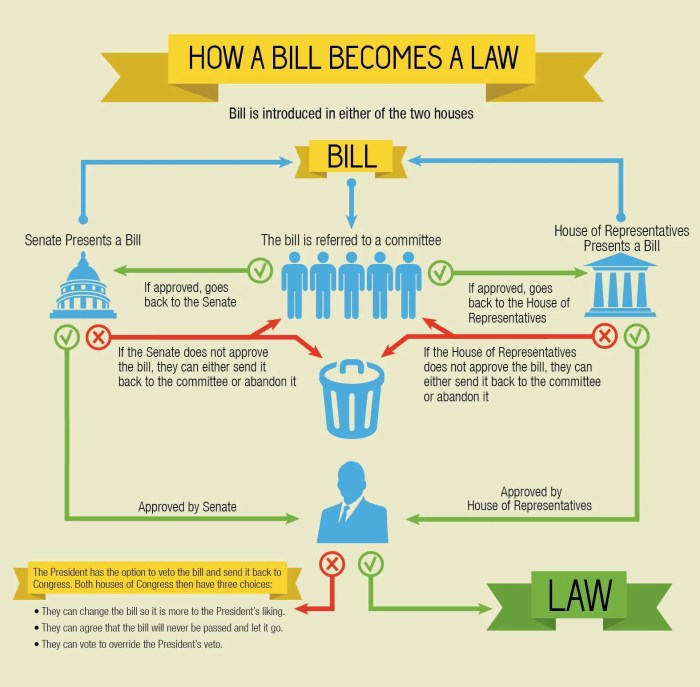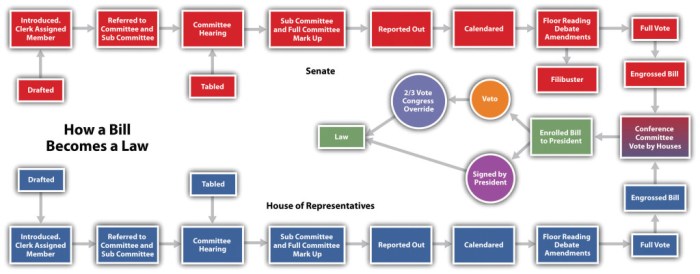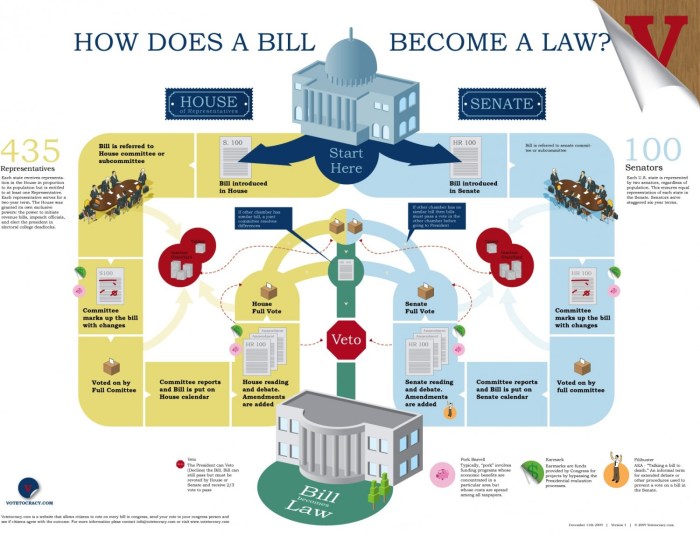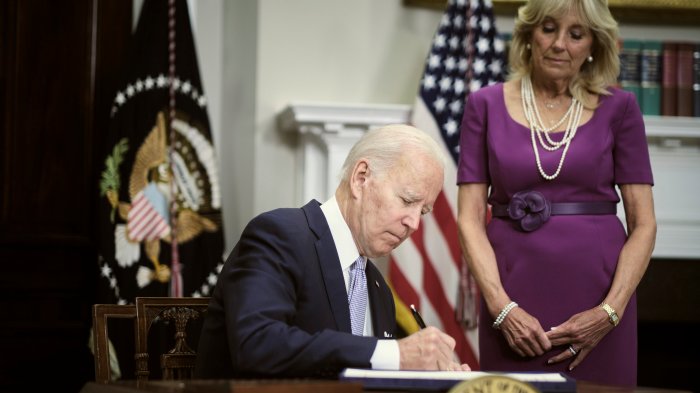
How does a bill become law? This question lies at the heart of American democracy, a process that transforms ideas into legislation impacting the lives of millions. From the initial introduction of a bill in Congress to the President’s ultimate decision, the journey is complex and involves a delicate balance of power and representation. Understanding this process empowers citizens to engage in the democratic process, ensuring their voices are heard and their interests considered.
The legislative process is a fascinating and often intricate dance between the legislative, executive, and judicial branches. It’s a system designed to foster deliberation, compromise, and ultimately, the creation of laws that reflect the will of the people. This journey begins with a simple idea, a proposed solution to a societal challenge, and culminates in a law that shapes our nation’s future.
Introduction
The legislative process is the journey a bill takes to become a law. It’s a complex system of checks and balances designed to ensure that laws are carefully considered and reflect the will of the people. Understanding how a bill becomes law is crucial for informed civic engagement and effective participation in the democratic process.
The Importance of Understanding the Legislative Process
Knowing how laws are made empowers citizens to advocate for their interests, hold their elected officials accountable, and participate meaningfully in shaping the policies that affect their lives. A clear understanding of the process allows individuals to engage in constructive dialogue, contribute to public discourse, and influence the direction of legislation.
The Role of Citizens in the Legislative Process
Citizens play a vital role in the legislative process. They can:
- Contact their elected officials to express their views on proposed legislation.
- Attend public hearings and provide testimony on bills under consideration.
- Organize and participate in advocacy groups that focus on specific policy issues.
- Vote in elections to choose representatives who share their values and priorities.
By actively engaging in these activities, citizens can contribute to the development of laws that reflect their needs and aspirations.
Bill Introduction and Sponsorship
Once a lawmaker has an idea for a new law, the first step is to introduce it to Congress. This is the formal process by which a bill is presented to the legislative body for consideration.
Bill Introduction
A bill is introduced by a member of Congress who is known as the bill’s sponsor. The sponsor is the primary advocate for the bill, and they are responsible for gathering support and guiding the bill through the legislative process. To introduce a bill, the sponsor must formally present it to the appropriate chamber of Congress (House of Representatives or Senate). This typically involves submitting the bill in writing to the clerk of the chamber. The bill is then assigned a number and is entered into the legislative record.
Bill Sponsorship
The role of a bill sponsor is crucial in the legislative process. They are responsible for:
- Drafting the bill: The sponsor works with staff and experts to ensure the bill is clearly written and reflects their intended policy goals.
- Building support: The sponsor must persuade other lawmakers to support the bill by explaining its merits and negotiating with potential opponents.
- Guiding the bill through the legislative process: The sponsor monitors the bill’s progress, attends hearings and debates, and works to secure its passage.
Types of Bills
Bills can be categorized into two main types:
- Public bills: These bills apply to the general public and affect everyone within the jurisdiction of the government that passed the law. For example, a bill that changes the federal minimum wage would be a public bill.
- Private bills: These bills apply to specific individuals, organizations, or situations. They are less common than public bills and typically deal with matters such as granting citizenship or resolving legal disputes.
Committee Consideration
Congressional committees play a crucial role in the legislative process by reviewing and shaping bills before they are considered by the full House or Senate. These committees are specialized groups of lawmakers with expertise in specific policy areas, such as health care, education, or defense. They act as filters, examining proposed legislation and making recommendations to the full chamber.
Committee Hearings and Markups
Committee hearings provide a forum for lawmakers, experts, and the public to discuss the merits and potential consequences of a bill. Witnesses, including government officials, academics, and advocates, present their perspectives and answer questions from committee members. These hearings help inform committee members about the bill’s potential impact and gather feedback on its provisions.
Following hearings, committees often hold markups, where they amend and revise the bill. Committee members propose changes, debate their merits, and vote on amendments. This process allows for the fine-tuning of the legislation and the incorporation of ideas from various stakeholders.
Examples of Committee Amendments and Rejections
Committees have the power to significantly alter or even reject bills. For example, in 2010, the Senate Health, Education, Labor, and Pensions Committee made significant changes to the Affordable Care Act during markup, including the addition of a public option for health insurance. In contrast, in 2017, the House Energy and Commerce Committee rejected a bill that would have repealed and replaced the Affordable Care Act, ultimately preventing it from advancing further in the legislative process.
Floor Debate and Vote
Once a bill has been approved by a committee, it moves to the floor of the House or Senate for debate and a vote. This is where the full chamber of lawmakers engages in a crucial process of discussing, amending, and ultimately deciding the fate of the proposed legislation.
Floor Debate
Floor debate is a critical stage in the legislative process, where members of the House or Senate have the opportunity to express their views on the bill, propose amendments, and engage in a dialogue about its merits and drawbacks. The debate can be lively and sometimes contentious, as lawmakers from different parties and viewpoints seek to influence the final outcome of the bill.
Role of Floor Leaders and Party Whips
Floor leaders, who are typically the majority and minority leaders in each chamber, play a pivotal role in guiding the debate and ensuring that their party’s priorities are addressed. They often set the agenda for the debate, determine the amount of time allocated for discussion, and negotiate with the opposing party on amendments.
Party whips, who are responsible for maintaining party discipline, work to ensure that their party members are present for votes and that they vote in accordance with the party’s position on the bill. Whips also act as liaisons between the floor leaders and the rank-and-file members, communicating the party’s strategy and ensuring that members are aware of the key issues at stake.
Types of Votes
After the debate, the bill is brought to a vote. There are different types of votes used in the legislative process, each with its own procedures and implications.
Roll Call Vote
A roll call vote is a formal vote in which each member’s vote is recorded individually. This type of vote is typically used for important bills or when there is a close vote.
Voice Vote
A voice vote is a less formal vote in which members indicate their approval or disapproval by saying “aye” or “no.” This type of vote is often used for routine matters or when there is a clear majority in favor of or against the bill.
Other Types of Votes
There are other types of votes that may be used in specific situations, such as a standing vote, where members indicate their vote by standing up, or a recorded vote, which is similar to a roll call vote but may be used for less important bills.
Conference Committee and Reconciliation
When the House and Senate pass different versions of the same bill, a conference committee is formed to reconcile the differences between the two versions.
Conference Committee Composition and Role
A conference committee is a temporary panel of members from both the House and the Senate, chosen by their respective leaders. Its purpose is to find common ground and produce a compromise version of the bill that both chambers can agree on. The committee’s members are typically chosen from the committees that initially considered the bill in each chamber. They are tasked with negotiating a compromise that addresses the key differences between the two versions of the bill.
Reconciling Differences
The conference committee process is a critical step in the legislative process. It allows for a thorough examination of the bill and ensures that both chambers have a say in its final form. The committee’s work can involve making significant changes to the bill, or it may simply be a matter of clarifying language or resolving minor discrepancies.
“The conference committee is a crucial part of the legislative process, as it provides a mechanism for resolving differences between the House and Senate and ensuring that a bill is acceptable to both chambers.”
Examples of Conference Committee Impact
Conference committees have played a significant role in shaping many landmark pieces of legislation. For example, the Affordable Care Act, passed in 2010, was the result of extensive negotiations between a conference committee. Similarly, the Dodd-Frank Wall Street Reform and Consumer Protection Act, passed in 2010, was also shaped by a conference committee. In both cases, the conference committee was able to bridge significant differences between the House and Senate versions of the bill, resulting in a final version that was acceptable to both chambers.
Presidential Action: How Does A Bill Become Law

The president plays a crucial role in the legislative process, acting as the final gatekeeper before a bill can become law. After both houses of Congress have passed a bill in identical form, the president has the power to either approve or reject it.
Presidential Options
The president has three options when presented with a bill:
- Sign the Bill: This signifies the president’s approval, and the bill becomes law.
- Veto the Bill: The president can reject the bill by issuing a veto. This sends the bill back to Congress with a statement explaining the reasons for the veto.
- Pocket Veto: This applies only when Congress is not in session. If the president does not sign a bill within ten days of receiving it, it is automatically vetoed without a formal statement. This is known as a pocket veto because the bill, in effect, “dies in the president’s pocket.”
Overriding a Presidential Veto
Congress can override a presidential veto with a two-thirds majority vote in both the House of Representatives and the Senate. This process demonstrates the power of Congress to enact legislation even against the president’s wishes. For example, in 1996, President Bill Clinton vetoed a bill that would have prohibited the use of federal funds for abortions. However, Congress overrode the veto, making the bill into law.
The Role of the Judiciary

The judicial branch plays a crucial role in the legislative process, ensuring that laws passed by Congress are consistent with the Constitution. This power of judicial review is fundamental to the American system of government, safeguarding individual rights and ensuring that the government operates within its designated boundaries.
Judicial Review of Laws, How does a bill become law
The courts’ ability to review laws for constitutionality is a cornerstone of the American legal system. This power, established in the landmark case of Marbury v. Madison (1803), allows the judiciary to strike down laws that violate the Constitution. This process involves examining the text of the law, considering its intent, and determining whether it conflicts with any provisions of the Constitution.
“It is emphatically the province and duty of the Judicial Department to say what the law is.” – Chief Justice John Marshall, Marbury v. Madison
The courts can review laws at various stages of the legislative process. They can examine a law before it is enacted, during its implementation, or even after it has been in effect for a period of time. This ongoing review ensures that laws remain consistent with the Constitution and that they are applied fairly and justly.
Concluding Remarks

As we’ve seen, the journey of a bill to becoming law is a testament to the democratic process. It’s a journey that requires collaboration, compromise, and ultimately, the will of the people. This process, while complex, serves as a powerful tool for enacting change and ensuring that our laws reflect the values and aspirations of our nation. By understanding this process, citizens can actively participate in shaping the future of our democracy.
Quick FAQs
What happens if a bill fails to pass through a committee?
If a bill fails to pass through a committee, it is effectively killed. The committee can either vote against the bill or simply choose not to bring it to a vote. In either case, the bill will not proceed to the floor of the House or Senate.
What is the difference between a public bill and a private bill?
A public bill applies to the general public, while a private bill applies to a specific individual or organization. For example, a public bill might create a new national park, while a private bill might grant citizenship to a specific individual.
Can a bill be amended during the legislative process?
Yes, bills can be amended during the legislative process. Amendments can be proposed by members of Congress, committees, or even the President. Amendments must be approved by a majority vote in both the House and Senate.
What is a filibuster?
A filibuster is a tactic used by senators to delay or block a vote on a bill. A senator can filibuster by speaking continuously on the floor of the Senate. To end a filibuster, a vote of cloture is required, which requires a supermajority of 60 senators.





